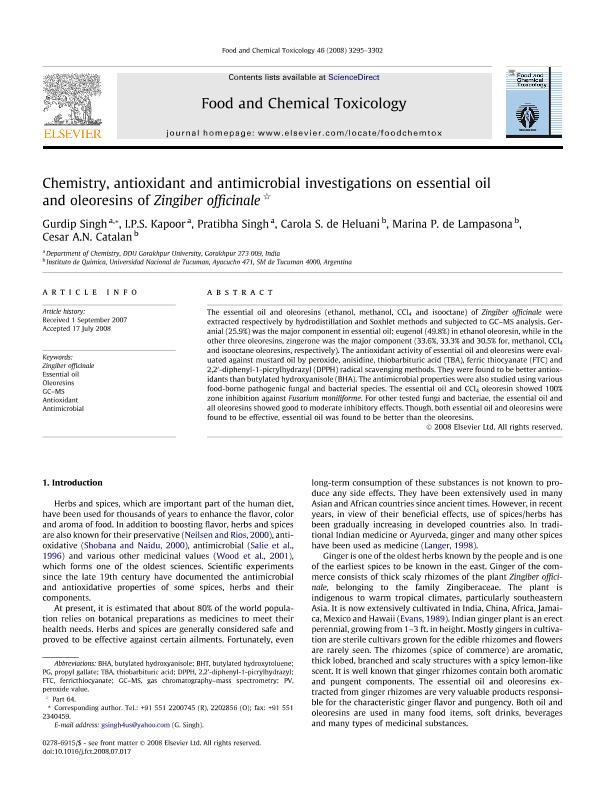Artículo
Chemistry, antioxidant and antimicrobial investigations on essential oil and oleoresins of Zingiber officinale
Singh, Gurdip; Kapoor, I.P.S.; Singh, Pratibha; de Heluani, Carola S.; de Lampasona, Marina P.; Catalan, Cesar Atilio Nazareno

Fecha de publicación:
05/2008
Editorial:
Pergamon-Elsevier Science Ltd
Revista:
Food And Chemical Toxicology
ISSN:
0278-6915
Idioma:
Inglés
Tipo de recurso:
Artículo publicado
Clasificación temática:
Resumen
The essential oil and oleoresins (ethanol, methanol, CCl4 and isooctane) of Zingiber officinale were extracted respectively by hydrodistillation and Soxhlet methods and subjected to GC-MS analysis. Geranial (25.9%) was the major component in essential oil; eugenol (49.8%) in ethanol oleoresin, while in the other three oleoresins, zingerone was the major component (33.6%, 33.3% and 30.5% for, methanol, CCl4 and isooctane oleoresins, respectively). The antioxidant activity of essential oil and oleoresins were evaluated against mustard oil by peroxide, anisidine, thiobarbituric acid (TBA), ferric thiocyanate (FTC) and 2,2′-diphenyl-1-picrylhydrazyl (DPPH) radical scavenging methods. They were found to be better antioxidants than butylated hydroxyanisole (BHA). The antimicrobial properties were also studied using various food-borne pathogenic fungal and bacterial species. The essential oil and CCl4 oleoresin showed 100% zone inhibition against Fusarium moniliforme. For other tested fungi and bacteriae, the essential oil and all oleoresins showed good to moderate inhibitory effects. Though, both essential oil and oleoresins were found to be effective, essential oil was found to be better than the oleoresins. © 2008 Elsevier Ltd. All rights reserved.
Palabras clave:
ANTIMICROBIAL
,
ANTIOXIDANT
,
ESSENTIAL OIL
,
GC-MS
,
OLEORESINS
,
ZINGIBER OFFICINALE
Archivos asociados
Licencia
Identificadores
Colecciones
Articulos(INQUINOA)
Articulos de INST.DE QUIMICA DEL NOROESTE
Articulos de INST.DE QUIMICA DEL NOROESTE
Citación
Singh, Gurdip; Kapoor, I.P.S.; Singh, Pratibha; de Heluani, Carola S.; de Lampasona, Marina P.; et al.; Chemistry, antioxidant and antimicrobial investigations on essential oil and oleoresins of Zingiber officinale; Pergamon-Elsevier Science Ltd; Food And Chemical Toxicology; 46; 10; 5-2008; 3295-3302
Compartir
Altmétricas



